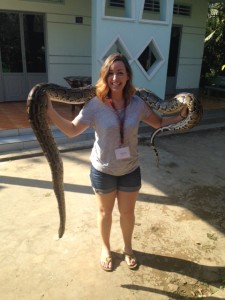On our final day in Singapore, there were no company visits or other “academic” components scheduled. Instead, students and faculty were able to select the Singaporean adventure of their own choosing.
Many students opted to explore the resort island of Sentosa, which features several beaches, a casino, theme parks, an aquarium, and numerous other attractions. Other students explored the Singapore Botanic Gardens. Several faculty members ventured to the undeveloped, government-preserved island of Palau Ubin. And, of course, beyond the excursions listed, many other adventures too varied and numerous to list were had.
To start off my free day, Wilburn Oziogu, Mitch Montgomery, and I enjoyed a round of golf at one of Singapore’s few public courses. The course was located some distance from the hotel, but luckily cabs are quite inexpensive in Singapore. It was a relatively short course, and only nine holes, so we opted to walk. Plus, from what we observed, it appeared that the majority of golfers at this course walk rather than drive a cart. This was welcome news to us, as we were happy to play at a leisurely pace and enjoy the warm weather.
Afterwards, Mitch, Wilburn, and I returned to the hotel. We joined up with Bryan Sulentic to have lunch. At this point, several of us were in the mood for some more “familiar” cuisine. Singapore has no shortage of American restaurants, so we headed to the nearby Chili’s where we feasted on a bottomless basket of chips and salsa and some cheeseburgers.
Thereafter, Mitch and I visited a nearby microbrewery called Brewerkz. Brewerkz is Singapore’s largest and oldest microbrewery. Its founders are U.S.-born and modeled it after similar establishments in the United States and Canada. We secured a table on its spacious, open-air patio, which overlooks the quay, and enjoyed a variety of craft beers.
That evening we met up with a number of others from our group to have dinner at the hotel’s poolside restaurant. Mitch, Michael Costolo, Scott Christopherson, and I went out for one final evening to an area of Singapore called Club Street. We visited several establishments there and, purely by happenstance, ran into Ryan Schork, Alissa Ohl, and Alex Small, three of the expats who spoke at the previous day’s expat panel. We shared a couple of drinks with our expat friends before heading back to the hotel.
In sum, our final free day was a great cap to an exciting and fun-filled trip that allowed everyone to experience Singapore on his or her own terms. No matter the activity chosen, it seems safe to conclude that everyone had a terrific time, which was just the thing needed prior to the long journey back to North Carolina.
Written by Chad Archer

